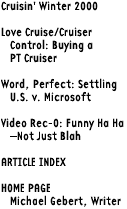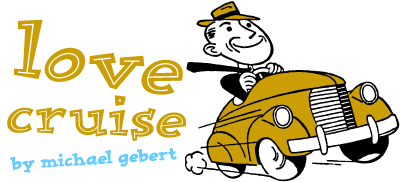


At first this breakthrough may seem obvious—isn’t the fact that some will love what others loathe the very basis of niche marketing? It took a German shrink to discover that? (I have a sudden vision from a 30s comedy of the late Sig Rumann.) Yet gaze across any parking lot, at the rows of Blanduses and Nondescriptas, and you’ll know that this has been exactly Detroit’s problem. Focus groups shaving every interesting edge off a company’s new performance sedan... until it looks exactly like every other performance sedan of the last 20 years.
It wasn’t like that in the 50s, when designers like Harley Earl gleefully stretched fins out to the point that American cars practically tipped backwards. Yet even with that history, Detroit didn’t take the hint until Apple reminded them of the selling power of bold design. Yes, Apple: what are the colors of the iMac if not the two tones of a ‘57 Chevy? From the iMac came the funky colors and anti-SUV Cute Chic of the new Beetle; and from that came the somewhat racier Cute Chic of the PT Cruiser, and everything that will now follow it.
And from the runaway success of all of these should also come this point about prompting a reaction: if a piece of work isn’t turning somebody off, it probably isn’t bold or distinctive enough to turn anybody on, either.

THE PROCESS OF GETTING MY PT CRUISER was my most interesting chance yet to observe how the Internet is changing retailing. Yes, I found a no-haggle dealer (with whom I had a very good experience) online—but even before that, I found out all about the not-yet-released car from a site called PTCruiserClub.org.
And by all about the car, I mean that I found out things like the day that regular production actually started in Toluca, Mexico, and the internal codes Chrysler uses to track a car’s progress along the assembly line, and the fact that when I placed my order didn’t have nearly as much to do with when I would actually get my Cruiser as where my dealer stood on Chrysler’s list of favored high-volume sellers.
Internal info like that, that dealers would have died to keep secret five years ago, is now routinely shared online by buyers—who in turn use it to question the fundamental assumptions of the biz. Seriously, why should my order be subject to a dealer’s status with Chrysler, any more than my chino order from J. Crew is subject to where my mailman stands with them?
If the first e-commerce revolution was a race to the lowest price, the second will come from the power of consumers to ask questions like that—and to do something about them in concert with others nationwide. Especially about retailers, like car dealers, that they never much liked in the first place.